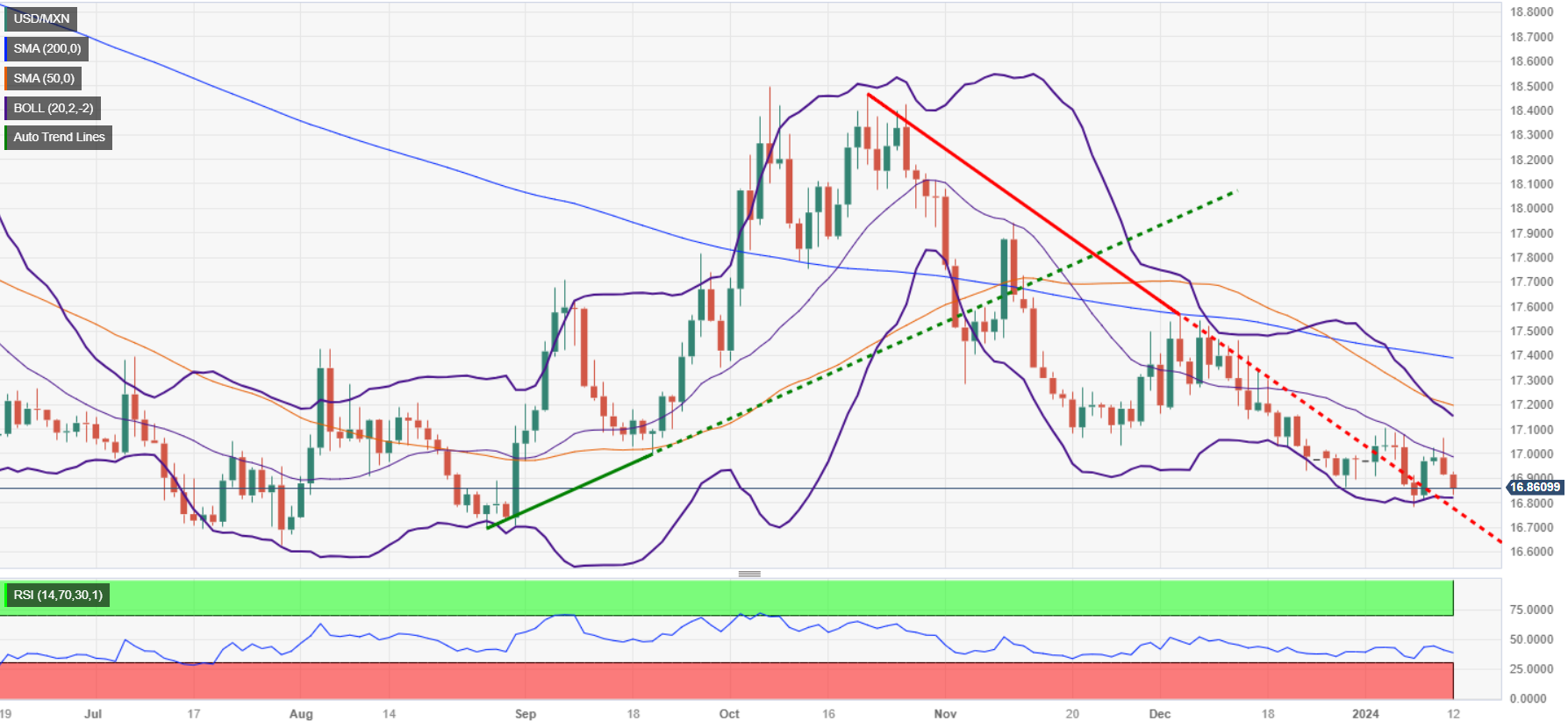- The Mexican Peso advances as investors expect significant US rate cuts, a headwind for the Dollar.
- Inflation and the drop in industrial production in Mexico, greater than expected, put Banxico at a crossroads.
- The USD/MXN pair retreats below 16.85 and traders are targeting a new multi-year low below 16.62.
The Mexican Peso (MXN) rose during the North American session against the US Dollar (USD) as investors increased their bets that the US Federal Reserve (Fed) would aggressively ease its monetary policy, setting a price of more than 170 base points of cuts. Therefore, the Dollar remains pressured, a headwind for USD/MXN, which has fallen 0.31% and is trading at 17.85 after hitting a three-day low of 16.82%.
Mexico's economic agenda remains thin, although the current week revealed that inflation was higher than expected in December, which could dissuade the Bank of Mexico (Banxico) from relaxing monetary policy in the first quarter. However, rising interest rates are beginning to affect the country's industries, as Industrial Production plummeted, harming growth prospects for 2024.
In this regard, Mexican President Andrés Manual López Obrador entered the arena of economic projections, projecting that the economy would grow 3.5%, exceeding the World Bank's forecast of 2.6%.
Across the border, the US Department of Labor announced that prices paid by producers fell in December, triggering a new rate cut by the US central bank, consequently weakening the Dollar.
Daily market summary: The Mexican peso rises on expectations of a dovish Fed.
- The Producer Price Index (PPI) did not meet expectations, as the monthly PPI decreased by -0.1%, below the 0.1% expected. In a year-on-year comparison, the PPI registered an increase of 1%, also below the 1.9% expected. Core PPI was unchanged at 0% from November data, below estimates. Furthermore, the core PPI fell from 2% previously to 1.8%, also below forecasts.
- Since Industrial Production has collapsed in Mexico, the country's scenario becomes uncertain, which could weigh on the Mexican peso.
- On Wednesday, the World Bank revised its economic projections for Mexico in 2024. The updated forecast anticipates Mexico's Gross Domestic Product (GDP) will grow 2.6%, an increase from the bank's initial prediction of 1.9%. The bank's analysts attribute this expected growth to the increase in near-shoring activities, which they believe will have a positive impact on the Mexican economy.
- Although the recent meeting minutes of Banxico (the Central Bank of Mexico) suggest that the central bank could consider easing its monetary policy, the December inflation report could hamper any move towards easing policy.
- On Tuesday, Mexico's Consumer Price Index (CPI) recorded a year-on-year increase of 4.66% in December, exceeding the 4.55% forecast. This is a significant jump from 4.32% in November.
- Core inflation, which excludes volatile items such as food and energy, registered a year-on-year increase of 5.09%, slightly lower than the consensus and the previous month's figures of 5.15% and 5.30%, respectively.
- On January 5, a Reuters poll suggested that the Mexican peso could weaken by 5.4%, to 18.00 per dollar, in the twelve months following December.
- On Thursday, Fed policymakers reiterated that cutting rates in March is too soon, while adding that while progress had been made on inflation, December data bucked the trend.
Technical Analysis: The Mexican Peso fights back and the USD/MXN falls below 16.90
The USD/MXN pair resumed its uptrend following an impulsive bullish correction that lifted the spot price towards its weekly high of 17.07 before reversing course below 17.00. As the downtrend progresses, the next key support levels to test would be 16.69 on August 28, followed by the 2023 low at 16.62.
Further rises will only be seen if buyers intervene, pushing the USD/MXN exchange rate above 17.00. The first resistance would be 17.20, followed by the 50-day SMA at 17.20, before challenging the confluence of the 100- and 200-day SMAs around 17.39/40.
USD/MXN Price Action – Daily Chart

Frequently Asked Questions about the Mexican Peso
What is MXN?
The Mexican Peso is the legal tender of Mexico. The MXN is the most traded currency in Latin America and the third most traded on the American continent. The Mexican Peso is the first currency in the world to use the $ sign, prior to the later use of the Dollar. The Mexican Peso or MXN is divided into 100 cents.
What is Banxico and how does it influence the MXN?
Banxico is the Bank of Mexico, the country's central bank. Created in 1925, it provides the national currency, the MXN, and its priority objective is to preserve its value over time. In addition, the Bank of Mexico manages the country's international reserves, acts as a lender of last resort to the banks and advises the government economically and financially. Banxico uses the tools and techniques of monetary policy to meet its objective.
How does inflation impact the MXN?
When inflation is high, the value of the Mexican Peso (MXN) tends to decrease. This implies an increase in the cost of living for Mexicans that affects their ability to invest and save. At a general level, inflation affects the Mexican economy because Mexico imports a significant amount of final consumption products, such as gas, fuel, food, clothing, etc., and a large amount of production inputs. On the other hand, the higher the inflation and debt, the less attractive the country is for investors.
How does the Dollar influence the Mexican Peso (MXN)?
The exchange rate between the USD and the MXN affects imports and exports between the United States and Mexico, and may affect demand and trade flows. The price of the Dollar against the Mexican Peso is affected by factors such as monetary policy, interest rates, the consumer price index, economic growth and some geopolitical decisions.
How does the Fed's monetary policy affect Mexico?
The exchange rate between the USD and the MXN affects imports and exports between the United States and Mexico, and may affect demand and trade flows. The price of the Dollar against the Mexican Peso is affected by factors such as monetary policy, interest rates, the consumer price index, economic growth and some geopolitical decisions.
Source: Fx Street
I am Joshua Winder, a senior-level journalist and editor at World Stock Market. I specialize in covering news related to the stock market and economic trends. With more than 8 years of experience in this field, I have become an expert in financial reporting.







